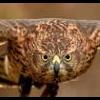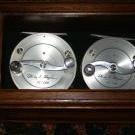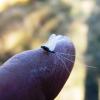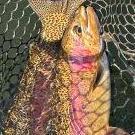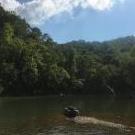
Al Agnew
Fishing Buddy-
Posts
7,072 -
Joined
-
Last visited
-
Days Won
26
Al Agnew last won the day on August 29
Al Agnew had the most liked content!
Profile Information
-
Gender
Male
Recent Profile Visitors
39,249 profile views
Al Agnew's Achievements

OAF Lifetime Member (89/89)
4.2k
Reputation
-
 WestCentralFisher reacted to a post in a topic:
Strange Occurrence Today
WestCentralFisher reacted to a post in a topic:
Strange Occurrence Today
-
Good point. Get yourself an app for your phone called Sim Daltonism. It's free, and supposedly will show you what things look like with various forms of color blindness. Bass supposedly see in dichromatic vision; they have well developed cones in their eyes for seeing red and green, but not blue. (We humans have trichromatic vision; we have cones for red, green, and blue. Some species have a greater range of vision than we do; they can see into the ultraviolet.) The app will show you what various colors look like to a bass, but only an approximation that should hold true in clear, shallow water. Light works very differently underwater than it does in the air, with various colors "disappearing" (actually turning greenish gray) at various depths as their wavelengths are absorbed by the water. A lot of what we THINK bass see in colors is totally untrue, and makes little sense in reality. However, because bass DO have red cones, they do see red, pink, and orange in something close to the same way we see them...as long as the water is clear and not too deep. But in the typically clear water of Ozark streams, those colors rather quickly turn to grayish green as you go deeper as the red and orange wavelengths are absorbed by the water. But they should still look pretty close to how we see them at the typical depths that you might drift an egg pattern.
-
 Ham reacted to a post in a topic:
Arkansas Chocolate Tarantula
Ham reacted to a post in a topic:
Arkansas Chocolate Tarantula
-
 Daryk Campbell Sr reacted to a post in a topic:
Arkansas Chocolate Tarantula
Daryk Campbell Sr reacted to a post in a topic:
Arkansas Chocolate Tarantula
-
 Quillback reacted to a post in a topic:
Arkansas Chocolate Tarantula
Quillback reacted to a post in a topic:
Arkansas Chocolate Tarantula
-
Hmm...Aphonopelma hentzi has always had the accepted common name of Texas brown tarantula. I've never before seen it called Arkansas chocolate. Usually there is just one universally accepted common name, decided upon by the taxonomists. But the accepted common name does occasionally change; for instance, black rat snakes now have the accepted common name western rat snake. I've seen a few over the years in Ste. Genevieve County. Can't remember seeing one anywhere else. One of them I saw was crossing the highway adjacent to our Ste. Genevieve County house. You know it's a big spider when you see it while driving! I know they are basically harmless, but I can see where it would scare the heck out of people who don't know much about spiders. Now THIS critter scares the crap out of me; I've seen a couple in the Ozarks, and yes, they are that big...giant red-headed centipede!
-
 Daryk Campbell Sr reacted to a post in a topic:
Dumb trips and people that take them
Daryk Campbell Sr reacted to a post in a topic:
Dumb trips and people that take them
-
 MOstreamer reacted to a post in a topic:
Dumb trips and people that take them
MOstreamer reacted to a post in a topic:
Dumb trips and people that take them
-
 Greasy B reacted to a post in a topic:
Dumb trips and people that take them
Greasy B reacted to a post in a topic:
Dumb trips and people that take them
-
 nomolites reacted to a post in a topic:
Dumb trips and people that take them
nomolites reacted to a post in a topic:
Dumb trips and people that take them
-
That's kinda typical fishing for the lower portions of so many of the Ozark rivers that slow down before they enter the flatlands. Once you reach the stretches where spotted bass predominate, it really is very seldom good fishing. I've had the same thing happen on the lower Strawberry, and on Castor River, Whitewater River, and every creek flowing into the Mississippi between St. Louis and Cape Girardeau...and now that I'm thinking of it, same thing many years ago on the Little Black, lower Black below Hendrickson, Crooked Creek in Bollinger County MO, Tavern Creek, Maries River. On some of these streams, the change is abrupt; you go from fast water and mostly smallmouth to slow water, nothing but spotted bass, and not a lot of spotted bass. I've done floats where I biked from the take-out back to the put-in to pick up my vehicle. One of the best ones is Big River at Washington State Park. It's about 3 miles from the Park boat ramp on Highway 21 to the park picnic ground, and about a 1.5 miles by road. The bad part is that it's about a half mile of steep uphill from the take-out to the top of the ridge, steep enough that I had to walk the bike up it. But once you reach the top of the ridge, it's all downhill from there, and you better have good brakes on your bike!
-
 Lloyd reacted to a post in a topic:
Late Summer Smallmouth Adventures
Lloyd reacted to a post in a topic:
Late Summer Smallmouth Adventures
-
 basska reacted to a post in a topic:
Late Summer Smallmouth Adventures
basska reacted to a post in a topic:
Late Summer Smallmouth Adventures
-
Mineral Fork produces some big fish, but some of those are big ones that winter on Big River and come up the Mineral Fork to spawn. I've fished Big River all my life, and have never seen, much less caught, a smallmouth there that I thought would break 6 pounds. I once had a memorable day on Mineral Fork where I and my brother put 13 smallmouth in the canoe that were over 17 inches...the biggest one was 19.5. (That was quite a few years ago, and I wouldn't expect to be able to do that today even though the access problem means some parts of it aren't pounded all that much.) So no, I don't think you'd ever catch a 7 pound plus smallmouth on the Mineral Fork.
-
90% of the people who catch good smallmouth vastly overestimate their weight, and often their length as well. That guy that dismissed 20 inchers probably has never caught a 20 incher, but believes the 18 inchers he's caught were 22 inches and 7 pounds. In reality, it takes a really chunky 20 incher to make 4 pounds. Most 18 inchers won't quite reach 3 pounds. The average person catches a 16 incher and thinks for sure that it's a 3-pounder, when it's probably not over 2 pounds. It's always been this way. Back 50 years ago, I would read the big hunting and fishing magazines, and there would be ads for guide services on the White River. Some of these guides also offered trips for smallmouth on Crooked Creek. They advertised that Crooked Creek was full of 3-5 pound smallmouth, with some reaching 6 pounds. I thought naively that Crooked Creek must be the mecca of big Ozark smallmouth. Later, I figured out that Crooked Creek is no more capable of producing 5 pound smallmouth than any other Ozark stream, and those 3-5 pounders were actually 16-18 inchers, and the 6 pounders might be 20 inchers. You always wonder, though, whether somebody else is catching bigger fish or more big fish than you are. I've caught a heck of a lot of big Ozark stream smallmouth, but there have been guys on here at times that swore they caught a lot more big fish than I ever have; that they catch these 4-5 pound smallmouth every time they go. Who knows, maybe it's true. I used to keep careful records, and when I did, I found that I caught something like one 18 incher per 10-12 hours of angling, and averaged maybe one legitimate 20 incher per 100 hours of fishing. I think that these days, my average on 18 plus inchers might be a little bit better, but the 20s still come darned rarely...seems like I catch a dozen 19 inchers for every 20. Anything that reaches 21 inches is pretty much the fish of a lifetime for most river smallmouth anglers, and a 22 incher is an incredible fish for anybody I know. I've been fortunate enough to catch a 22 incher and a rather slender 22.5, both of which weighed 5 pounds even on a scale that probably wasn't completely accurate. In recent years I've caught a couple that were 21.5 inches or slightly longer, but didn't reach 22 inches. But my heaviest smallmouth ever, no matter where caught, was a 21.5 incher caught in Minnesota where they are a lot thicker and heavier for their length; I didn't weigh it but I'm certain it weighed more than any smallmouth I've ever caught in the Ozarks. However, I consider the biggest smallmouth I've caught in the Ozarks were "better" catches because they come so few and far between. The thing I strive to do in smallmouth fishing is to catch GOOD fish consistently, using the lures and techniques I like to use. If you catch plenty of good fish, a big one will come along now and then. One of my fishing buddies classifies fish like this: there are "nice'uns", those fish that are better than average, like 15 inch smallmouth. "Good'uns", like 17 inchers. "Big'uns", like those 18-19 inchers. And "Holy crap, what a fish'uns", the ones over 20.
-
You are correct. That's the gauge for Greer Spring, and is pretty much useless in itself for gauging the river either above or below Greer. In times of low water like now, about the only thing you can possibly glean from it is to figure that the river above the spring is probably flowing less than 100 cfs, so if you take the flow of the spring (right now 411 cfs) and add 50-75 cfs to it, you'll get the flow of the river directly downstream from Hwy. 19.
-
The low water bridge at the Leadwood Access is still, thankfully, pretty much the cut-off point for spotted bass. I've only caught a couple upstream from it, while downstream they make up 30-40% of the bass population. I'd never caught any above it until three or four years ago.
-
If you examine the gauges a little more closely, you'll notice that the river has been significantly higher than the median for the whole summer. The gauge at Bardley is at 832 cfs right now after having slowly dropped from 850 to 810 cfs throughout the week. The median, which is a good approximation of normal for this time of year, is around 400 cfs. Why is that, you ask? Check out the gauge for Greer Spring. It's been hanging around 410-420 cfs, while the median is around 270 cfs! Apparently the groundwater that supplies Greer and other springs within the Eleven Point watershed is very well recharged from all the rain earlier, and the springs are still pumping out a lot more water than they normally would be at the end of summer. So yeah, the river is higher than it normally is (though unless it's more than three times the median, I don't worry much about the fishing; it will still be clearish and fishable). That does not mean it will be floatable above Greer. I floated Cane Bluff to Greer a few weeks ago. The Bardley gauge then was showing around 970 cfs, and the river up there was barely floatable, maybe flowing about 90-120 cfs if I had to guess (you need a minimum of 100 cfs for relatively easy floating). By now, barring a rise from rain, it will be well below 75 cfs.
-
Hey, I'm old. The first time I used it was, as near as I can remember, about 43 years ago, on my wife (who wasn't yet my wife at the time). And I've used it about as much on other people as on myself. So 10 or 12 times on myself in more than 40 years doesn't seem that excessive to me.
-
It will still come out easily unless, like the one in me, it's in the very tip where you can't push against the eye in the proper direction. And I'll bet the emergency room doctor didn't use the string trick. It's amazing to me the number of doctors that don't know it. I once argued up and down with the doctor brother of my fly fishing buddy about it. He was sure it would never work, even after I told him I'd used it more than a dozen times with no problems. (Now, I think I'm up to 22 times that I've used it.)
-
Not really. The thin dark lines of connected spots on the lower sides are never seen in pure smallmouth, but are found in spotted bass, Guadalupe bass, and all the new species that were once considered redeye bass. The dark blotches actually look more like shoal bass.
-
I make my own. Body is about 3.5 inches.
-
So every summer we spend July and early August in Montana to escape the Missouri heat and humidity, and then sometime in August we come back to Missouri so I can get some late summer floatfishing in, and make a trip up north to probably the best smallmouth river in the country. But this year was different. Mary is struggling with a stress fracture in her hip, and on crutches, but she's doing a lot better than she was a week before, so she told me I should go back to Missouri by myself. My buddy couldn't go up north when I could. So I flew back to Missouri, intending to stay about 2 1/2 weeks and get in as much fishing as possible. Usually, I would do at least one multi-day float on my favorite small, not hardly floatable stream. But maybe I'm getting old. I just wasn't too enthused about camping on the river. So my plan was to head down to Arkansas, rent a hotel room, and spend three days fishing different sections of the Buffalo. Driving down that Monday evening, I crossed Crooked Creek, and thought that maybe I should try it. When I got to the hotel room (Buffalo Point Inn near Dillard's Ferry on Hwy. 14), I looked up a shuttle guy and arranged a float on Crooked the next morning. I had never floated this particular section of Crooked Creek, but I think I'll float it again sometime. I had four fish in the canoe before I was out of sight of the truck, including a 17.5 incher. The fishing then slowed for a while, but gradually picked up until it became one of those days where you could predict when you'd catch a fish, and there were a LOT of places where I predicted catching a fish. The fish were simply exploding on topwater lures, especially plopper types. And I mean just blowing up on them AND getting hooked. I doubt that I had more than a dozen strikes from good fish all day that I failed to boat them. Plenty of 14-16 inchers, 7 or 8 between 17 and 17.5, and a couple 18s....and 90 smallmouth altogether. And for some reason, those fish were HOT. Some of the hardest fighting smallmouth I've caught in a long time. I had one bend the split ring on the belly hook until it sprung open. I broke a rod on another one, an 18 incher that kept trying to take me under a log. I put pressure on it repeatedly, and finally the thing broke my rod in half. But I ended up getting it anyway. And I didn't see a single person all day until I was a half mile above the take-out, where I came upon a young guy fighting a nice smallmouth and talking to himself. He landed it and was shouting, "YES, YES". Then he saw me and was probably embarrassed, but was also proud of that fish, which looked to be about 17 inches. Got off the river about 6 PM, ate supper in Yellville, and headed for the hotel, stopping at one of the outfitters in that area to arrange a shuttle on the Buffalo the next day. I wanted to go from Maumee to Dillard's Ferry. He said they hadn't put many people in a Maumee this summer because the road was so bad. So I thought I'd better drive down it before dark to check it out. It wasn't that bad, didn't need 4WD. So I was set for the next morning; I was going to get on the river shortly after daylight, and leave my truck for the outfitter to move later in the day. I got up before dawn and headed for the river. Got all the way down into the canyon, only a quarter mile from the access...and there was a huge tree down across the road! So I headed back, parked at the outfitter and waited for them to open at 7:30 AM. Arranged to float Dillard's Ferry to Rush instead, and finally got on the river about 8 AM. The Buffalo was considerably slower fishing. It was low, barely floatable (Crooked Creek had also been low and barely floatable), and the fish were scattered. But I did end up catching about 45 fish, with the biggest being a couple 17.5 inchers, mostly on the plopper again. No other anglers, one family group of splash and gigglers was all I encountered. So instead of another day on the Buffalo, I called up the Crooked Creek shuttle guy and arranged another float on a different section for the third day. I wanted to head the 4 plus hours to home after the trip, so I picked a shorter section. The shuttle guy said he had put in a couple anglers that day, and they reported catching only one fish between them, so he asked if I wanted to do the section I'd done before since it had been so good. "Nah, I probably know more about what I'm doing than those guys." Well, at first I was beginning to wonder. I fished a couple pools of the kind where I'd caught fish like crazy before, and nothing. But I guess I just needed to get a bit farther from the access, because soon I was catching fish regularly. It was almost as fast as the first day, but because it was a shorter float I "only" caught about 50, though 7 of them were between 17 and 18 inches. The plopper was doing well, but I started catching a bunch of fish on a bladed jig, and it seemed the bigger ones were on it. I gotta wonder what the heck those guys the day before were doing; it seems like they'd just accidentally catch more than one fish. I was about halfway through the float and it was about time for lunch when I heard a boat coming from behind me. It was a solo guy, and when he saw me he stopped, apparently to eat lunch himself. So I floated for another hour before stopping. Then about an hour later he caught up to me again. He was in a craft that could maybe charitably be called a solo canoe, but I'd never seen anything like it; it was kind of a cross between a canoe and a bathtub, made out of cheap fiberglass and apparently heavy. I was able to float most of the riffles without dragging, but this guy was having to get out and walk every riffle. He went on out of sight and I stopped to give him plenty of time to get far ahead of me. The fishing didn't get any worse after he passed me, though he said he was doing well. I finally caught up to him right before the take-out, and he was really pleased with what he'd caught. I had one mishap; I stuck a hook in the end of my little finger when a fish flopped at the wrong time. I always get hooks out with the string trick, but this was just not conducive to using it; the hook was right on the tip of the finger where there was no way to put pressure on the eye of the hook, and it was almost all the way through; the tip of the point was visible on the other side of the finger. So I pushed it on through (remembering once more how difficult that can be and how much it hurts), clipped it off, and got it out. Fishing with two and three treble hook lures, I'm always as careful as possible when handling hooked fish, and I started carrying a net a few years ago to net anything that didn't have a clear shot at lipping it. But it's going to happen once in a while. I finished the float in early afternoon of a really hot day; I'd jumped in the river several times to cool off. My truck was where it was supposed to be, sitting in the sun, and the inside like an oven. Loading up was the hottest I'd been all week, but the air conditioner cooled things down quickly once I was loaded. I took a different route home, not in any huge hurry. Friday and Saturday were restful days at home by myself. On Sunday, a buddy and I decided to float a short section of the Bourbeuse near home. It was a section that we'd really done well on last year about this time. This year wasn't last year. Between the two of us, we caught maybe a dozen fish, nothing of any size. I've only been on the Bourbeuse twice this summer, and both times it sucked. I was trying to decide what to do the next week when my friend Clyde called me Sunday evening. He was headed down to stay in a motel in Eminence, and float the Jacks Fork and/or Current all week. He said, "Why don't you come down. There are plenty of rooms available at the motel. We can do our own shuttles and not have to pay an outfitter." I told him I might be down Monday evening, but not before. He floated the poorest section of the Jacks Fork on Monday and caught very little. I drove down Monday evening, and we planned to float a different section of the Jacks Fork on Tuesday. The fishing rivaled Crooked Creek the week before. The fish were tearing up the plopper for both of us, and we caught 7 or 8 between 17 and 18.5 inches, and a total of over 110 fish between us. It was a great day. Not only that, but a good rain Monday night raised the river 6 inches, making it easily floatable. And we didn't see a single person until we got to the take-out, where there was a guy fishing for something with a couple rods propped up on sticks. The next day, Wednesday, we decided to float the upper Eleven Point. After the day before, a 65 fish day was a disappointment, and it started out really bad. We floated the first three hours without catching more than 6 or 7 fish, but then we passed a tributary and the fishing picked up considerably. I ended up catching a 19 incher, my biggest of the whole trip, and we had several others around 18 inches. Clyde was catching them on the plopper, but I was doing damage with the bladed jig. Again, it was a day with zero people. We planned on driving home Thursday evening, so we did a shorter Jacks Fork float Thursday. It wasn't as good as Tuesday had been, but we caught around 50 fish, again on ploppers and the bladed jig. One more day with nobody else on the river. Friday, Saturday, and Sunday, I did some yard work and chores around the house. I was slated to fly back to Montana on Thursday (tomorrow), and I thought I'd get in a couple more days of fishing Monday and Tuesday. Liking the idea of staying in a motel, I reserved a room in Lesterville, called my Black River shuttle guy, and took off for the Black before dawn Monday morning. I floated an upper section Monday, and the fishing was spectacular, again on the plopper and bladed jig. I had my highest total of the whole 2.5 weeks, over 90 fish, with several over 17 inches and a couple 18 inchers. The second 18 incher came in the pool at the take-out. So I was really looking forward to Tuesday, when I'd float downstream from the first stretch, in a section where I've always caught bigger fish. What a difference a day makes. I caught a grand total of 10 fish, none of any size, though I did hook and lose one that was pushing 20 inches. This year's floods have really messed up that section of river; the banks were scoured, the river was wider and shallower than I remembered it, and the habitat just wasn't there like it had been. I also stuck another hook in myself, this time when I set the hook in a fish on the surface and missed, and the lure came flying back and stuck me in the arm just below the elbow. Using the string trick to get a hook out of an arm or hand isn't easy when you're by yourself, since you kinda need two hands to get the job done. But I was able to go to the bank, push the eye of the hook against a snag, and pop it out. I finished the float before the shuttle guy got my truck down to the take-out, and had to wait a half hour before he got there. So I wasn't going to fish today, but I changed my mind. I did a float on Big River, not on one of my favorite sections, but on a pretty decent stretch. It was another slow day, with 35 fish caught and one 18 inch smallmouth and a 17 inch largemouth. Nothing was working consistently, but I caught a fish now and then on everything I tried. So, in 2.5 weeks, 10 days of floatfishing, something like 560 fish caught, somewhere between 40 and 45 over 17 inches. Only two other bass anglers seen. My thumbs are sore.
-
Funny thing is, I just got back from a trip to Arkansas, and fished the Buffalo and Crooked Creek. In three days I caught around 170 bass, nearly all on topwaters. Only disappointment was that I didn't break 18 inches, but I caught 14 between 17 and 18 inches.
-
Upper Jacks Fork won't have enough water. Alley to Eminence will have enough water but fishing is poor. Eminence to Two Rivers would be your best bet on the JF. As for Current...either fish for trout from Tan Vat to Akers, with scattered smallmouth, or fish for smallmouth from Round Spring to Two Rivers. Float Akers to Round Spring for the scenery, not the fishing.

